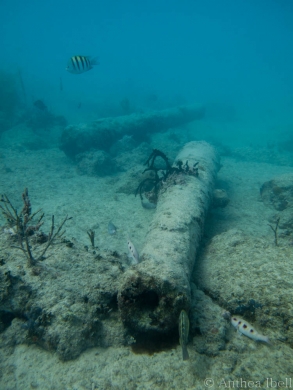Professor Charlie Beeker from Indiana University has been working on preserving shipwrecks in the Dominican Republic for many years. His current project is called Living Museums of the Sea, where he aims to create local dive sites to increase awareness about the archaeology and marine biology of the area. The three 2011 scholars visited Charlie in the Dominican Republic for a week to help carry out rapid assessments of the three Living Museums sites as well as general site maintenance.
The three Living Museums of the Sea sites include the wreck of Captain Kidd’s Quedagh Merchant, which Professor Beeker and his team discovered in 2007. It is a 17th Century wooden ship whose remains sit in only a few metres of water. The wreck is made up of mainly cannons but also includes broken pieces of the wooden structure that have been buried in the sand for many years. Diving the site we assessed the coral growth and checked the marker buoys.
The Living Museums of the Sea site that we spent the most time on during our visit was the Nuestra Senora de Guadalupe, 1724. The artificial reef site is made up of cannons confiscated from treasure hunters in the area. Here we also assessed the biodiversity on the site and using the information gathered on the rapid assessment, we made up templates for educational materials for the local dive shops and education centres.
On our last day in the Dominican Republic Charlie took us to one of his most important archaeological sites, Padre Nuestro cavern. The remains of extinct primates and sloths have been found here and this prehistoric archaeology is the side of underwater archeology that I am the most interested in. We donned our gear and clambered down the steep track to the small spring. Descending down into the cavern we were welcomed by big stalactites and stalagmites, reminders that this cave was once dry. The rubble shelves inside the cave were scattered with bones, many of which are those of a recently abandoned horse carcass, but Charlie showed us small artifacts including pieces of Tiano pottery and bones of sloths. His passion for allowing the general public to share in the local archaeology
and important finds has not stopped with shipwrecks. He is planning to place replicas of the removed pieces back into the cavern and advertise the cavern site to visiting tourists so they too can learn about the past of the Dominican Republic.
Many thanks to Charlie Beeker for his invitation to the Dominican Republic. His support for the scholarship has been overwhelming and I hope that future scholars are able to share the amazing experience with him. I would also like to thank his team of volunteers, including many Peace Core workers who welcomed us and shared many interesting stories about living in the Dominican Republic.














